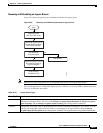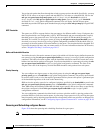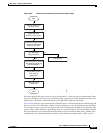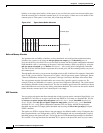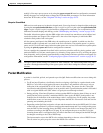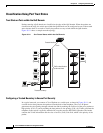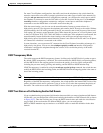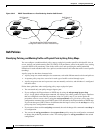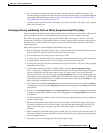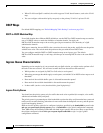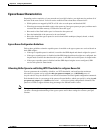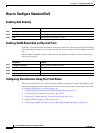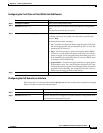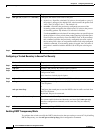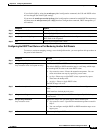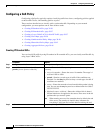
38-29
Cisco IE 2000 Switch Software Configuration Guide
OL-25866-01
Chapter 38 Configuring Standard QoS
Information About Standard QoS
• You can configure a separate second-level policy map for each class defined for the port. The
second-level policy map specifies the police action to take for each traffic class. For information on
configuring a hierarchical policy map, see
Classifying, Policing, and Marking Traffic on SVIs by
Using Hierarchical Policy Maps, page 38-29.
• A policy map and a port trust state can both run on a physical interface. The policy map is applied
before the port trust state.
Classifying, Policing, and Marking Traffic on SVIs by Using Hierarchical Policy Maps
You can configure hierarchical policy maps on SVIs, but not on other types of interfaces. Hierarchical
policing combines the VLAN- and interface-level policy maps to create a single policy map.
On an SVI, the VLAN-level policy map specifies which traffic class to act on. Actions can include
trusting the CoS, DSCP, or IP precedence values or setting a specific DSCP or IP precedence value in
the traffic class. Use the interface-level policy map to specify the physical ports that are affected by
individual policers.
Follow these guidelines when configuring hierarchical policy maps:
• Before configuring a hierarchical policy map, you must enable VLAN-based QoS on the physical
ports that are to be specified at the interface level of the policy map.
• You can attach only one policy map per ingress port or SVI.
• A policy map can contain multiple class statements, each with different match criteria and actions.
• A separate policy-map class can exist for each type of traffic received on the SVI.
• A policy-map and a port trust state can both run on a physical interface. The policy-map is applied
before the port trust state.
• If you configure the IP-precedence-to-DSCP map by using the mls qos map ip-prec-dscp
dscp1...dscp8 global configuration command, the settings only affect packets on ingress interfaces
that are configured to trust the IP precedence value. In a policy map, if you set the packet IP
precedence value to a new value by using the set ip precedence new-precedence policy-map class
configuration command, the egress DSCP value is not affected by the IP-precedence-to-DSCP map.
If you want the egress DSCP value to be different than the ingress value, use the set dscp new-dscp
policy-map class configuration command.
• If you enter or have used the set ip dscp command, the switch changes this command to set dscp in
its configuration. If you enter the set ip dscp command, this setting appears as set dscp in the switch
configuration.
• You can use the set ip precedence or the set precedence policy-map class configuration command
to change the packet IP precedence value. This setting appears as set ip precedence in the switch
configuration.
• If VLAN-based QoS is enabled, the hierarchical policy map supersedes the previously configured
port-based policy map.
• The hierarchical policy map is attached to the SVI and affects all traffic belonging to the VLAN.
The actions specified in the VLAN-level policy map affect the traffic belonging to the SVI. The
police action on the port-level policy map affects the ingress traffic on the affected physical
interfaces.
• When configuring a hierarchical policy map on trunk ports, the VLAN ranges must not overlap. If
the ranges overlap, the actions specified in the policy map affect the incoming and outgoing traffic
on the overlapped VLANs.
• Aggregate policers are not supported in hierarchical policy maps.



